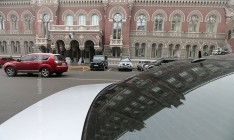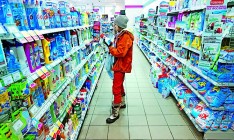Economy
Financial resultsLosses of Ukrainian businesses grew by more than 3.5 times

In January—September 2014 the total losses of Ukrainian companies amounted to UAH 168 bn, according to the State Statistics Service. This is the worst result in all the years of Ukrainian independence.
In fairness it should be noted that not all the businesses went into the red. More than 55% of the companies finished nine months with a profit. The overall result was even better than last year — the profit for the three quarters reached UAH 215.5 bn, whereas last year profitable business entities collectively earned UAH 130 bn. Nevertheless, the general indicator is in the negative range. Nearly 44% Ukrainian companies went into the red in January—September with total losses of UAH 383.5 bn. This is more than 3.5 times worse than the indicators in 2013, when losses of outsider companies in the same period were UAH 107.4 bn.
Victims of the crisis
The greatest losses were registered in the industrial sector. Industrial production in Ukraine is in rapid decline — 9.4% since the beginning of the year and this is not only due to low demand of consumers. Many businesses in the east are located on territories controlled by insurgents. Part of the industrial infrastructure was physically destroyed during the military operations.
Admittedly, the impact on financial and economic activities of business entities of the poorly predicted situation on the currency market is no less negative than the actions of the authorities of the self-proclaimed DPR and LPR. Back in September commenting on financial results for the first half of the year DTEK said that following devaluation of the national currency — and it was probably the decisive factor — the total losses of the company’s enterprises exceeded UAH 8.6 bn.
The gloomy statistics of the SSS are confirmed by the Metallurgprom Association. For the nine months of 2014 iron ore and steel works incurred pre-tax losses of UAH 14.3 bn (62.5%) compared to the same period last year. This is despite the fact that the net profits of companies that are members of Metallurgprom from product sales increased by 16.4% to UAH 126.8 bn. Nevertheless, the increased revenues were leveled by losses due to the exchange rate in the process of revaluation of foreign currency loans and their interest rates. In addition, as General Director of Metallurgprom Oleksandr Zrazhevskiy explained, the cost of raw materials was significantly raised this year. In particular, prices for iron ore increased by 19–30%, refractories — by 17–24%, ferroalloys — by 21–40%, coke — by 25% and scrap metal — by 19%. Energy prices went up as well: the price of natural gas increased by 18% and the price of electricity — by 10%.
Exception to the rule
However, the situation is not that grim for all companies in the industry. For example, pharmaceutical companies and furniture manufacturers managed to finish three quarters of the year with profits, though they did not achieve last year’s results. Only extraction enterprises managed to work at the same level over nine months of the year. Their pre-tax profits in January—September were UAH 16 bn.
«Despite that the volumes of oil and gas extraction are practically not growing in Ukraine and that there is a crisis in the coal industry for obvious reasons (many mines are located in the ATO zone), the overall financial result of the extraction industry is positive. First of all, this is due to the contribution of enterprises in the iron ore industry,» said Head of the Analytical Department at the investment company Eavex Capital Dmytro Churin. Iron ore deposits are concentrated in the Dnipropetrovsk oblast, therefore, according to Churin, the activities of companies in this region were much less exposed to the complicated situation in the eastern regions of the country bordering on Russia. Churin says that for the Metinvest Group mining and processing enterprises have traditionally been a profit center in the entire production chain.
Farmers’ lot
The situation in the agricultural sector is not as clear as in other industries. As the SSS reported, indicators of crop and livestock production are not taken into account when companies calculate their quarterly financial results. This means that for now it is impossible to estimate the most profitable sectors of the agribusiness on the basis of official data.
Nevertheless, the information provided by the companies themselves, shows that the agricultural sector is likely to be no exception to the rule as it will most likely also go into the red. For example, Milkiland reported in January—September a net loss of EUR 34.84 mn, although over the same period last year the company had a net profit of EUR 11.01 mn. Due to the devaluation of the hryvnia and the Russian ruble Milkiland’s exchange losses over nine months amounted to EUR 41.9 mn. Astarta Agrarian Holding also sustained losses. For the nine months of the year its financial results dropped by EUR 21.48 mn, though last year the company showed a profit of EUR 82.4 mn.
Representatives of the agrarian holding company MHP also officially announced losses over three quarters. Over nine months it reported a net loss of US $302 mn, compared to US $150 mn in net profits in January—September 2013. Once again, farmers blame the devaluation of the hrynvia for these losses. According to the company, over nine months largely due to foreign exchange fluctuations the company’s losses were US $561 mn. However, the collapse of the hryvnia was not the only problem. «Among the difficulties our company faced this year was the ban on import of products to the Customs Union (CU) countries in February, as well as the temporary shutdown of the Shakhtarska Nova poultry farms (Donetsk oblast), which produced 30% of the holding’s hatching eggs,» said Chairman of the Board of Directors of MHP Yuriy Melnyk.
The MHP was not the only company affected by the problems caused by the trade war between Russia and Ukraine. The loss of the Russian market cost Ukrainian agricultural producers in the first three quarters of 2014 almost US $140 mn, according to calculations of the Ukrainian Agribusiness Club (UAC) and that is only the amount for the supply of meat, dairy and vegetable products, said President of the UAC Alex Lissitsa.
The increase in the volume of exports of agricultural products to the EU covered the loss of exports to Russia, he said. Within the nine months Ukrainian manufacturers supplied to Europe products worth US $150 mn. Representatives of the MHP confirmed that export diversification helped minimize the loss from the ban from CU markets in general and the Russian market in particular.
Staying afloat
The situation in the commercial sector is ambiguous. Most of the companies engaged in wholesale and retail sales made profits over three quarters of the year having earned approximately UAH 25.3 bn. However, the cumulative loss of the outsiders surpassed the amount of profits of successful players.
General Director of the Ukrainian Trade Association Ihor Kyshko says the losses of companies are the result of the annexation of Crimea and hostilities in the Luhansk and Donetsk oblasts. Kyshko added that companies are going out of business in Crimea. In the Donbas region retailers «have either closed shop or are on the way out», said Kyshko.
Earlier CEO of the ATB Corporation Borys Markov said that retailers have almost no opportunity to work in the occupied territories. Their stores are being robbed and shelled. Traders are also as pessimistic as the average consumer. The decline in retail sales is observed not only in the east, but across the entire country.
In October, retail turnover decreased by 6.8% — the worst result over the last five years. The reasons are obvious: the rise in consumer prices on the backdrop of lower consumer demand. This year, the average salary in Ukraine grew by only 9.5%, while the price index increased by 19%.
Best of the best
Only two sectors showed profits — education and finance and banking, according to the SSS. Moreover, even experts were surprised with the results of the financial sector. After all, this year even the banking system showed a loss of UAH 10.6 bn over three quarters of the year, according to the NBU. At the same time, the insurance sector and stock markets have been operating in the red for many years.






 of the agreement of syndication with Financial Times Limited are strictly prohibited. Use of materials which refers to France-Presse, Reuters, Interfax-Ukraine, Ukrainian News, UNIAN agencies is strictly prohibited. Materials marked
of the agreement of syndication with Financial Times Limited are strictly prohibited. Use of materials which refers to France-Presse, Reuters, Interfax-Ukraine, Ukrainian News, UNIAN agencies is strictly prohibited. Materials marked  are published as advertisements.
are published as advertisements.